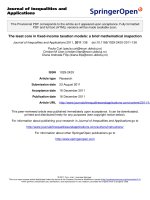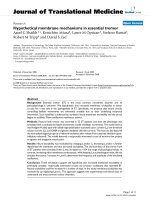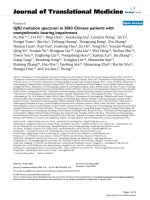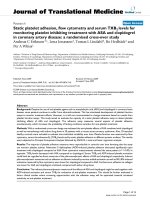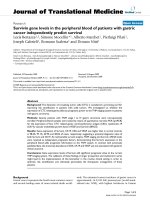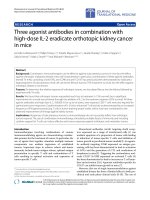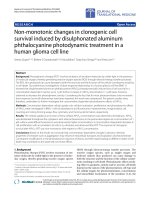báo cáo hóa học: " Soluble HLA measurement in saliva and cerebrospinal fluid in Caucasian patients with multiple sclerosis: a preliminary study" pdf
Bạn đang xem bản rút gọn của tài liệu. Xem và tải ngay bản đầy đủ của tài liệu tại đây (470.07 KB, 7 trang )
BioMed Central
Page 1 of 7
(page number not for citation purposes)
Journal of Neuroinflammation
Open Access
Research
Soluble HLA measurement in saliva and cerebrospinal fluid in
Caucasian patients with multiple sclerosis: a preliminary study
Irena Adamashvili
1
, Alireza Minagar
1
, Eduardo Gonzalez-Toledo
2
,
Liubov Featherston
1
and Roger E Kelley*
1
Address:
1
Department of Neurology, LSU Health Sciences Center, 1501 Kings Highway, Shreveport, LA 71130 USA and
2
Department of Radiology,
LSU Health Sciences Center, 1501 Kings Highway, Shreveport, LA 71130 USA
Email: Irena Adamashvili - ; Alireza Minagar - ; Eduardo Gonzalez-Toledo - ;
Liubov Featherston - ; Roger E Kelley* -
* Corresponding author
Abstract
Background: Measurement of soluble HLA in body fluids has a potential role in assessing disease
activity in autoimmune disorders.
Methods: We applied a solid phase, enzyme-linked immunoassay to measure soluble HLA class I
(sHLA-I) and class II (sHLA-II) molecules in the saliva and cerebrospinal fluid (CSF) in 13 untreated
patients with relapsing-remitting form of multiple sclerosis (MS). For comparison purposes, we also
studied saliva from 53 healthy subjects.
Results: Saliva from normal controls had detectable sHLA-I levels in 41 of 53 individuals studied,
with values ranging from 9–100 ng/ml (mean = 41 ± 2.8 ng/ml). sHLA-I was undetectable in the
saliva in 11 of 13 MS patients, and in none of the CSF specimens. In contrast, mean sHLA-II
concentration in the saliva of MS patients was significantly increased compared to controls (386 ±
52 unit/ml vs. 222 ± 18.4 unit/ml, t = 8.68, P < 0.005). The mean CSF sHLA-II level (369 ± 16 unit/
ml) was equivalent to the mean sHLA-II concentration measured in saliva (mean = 386 ± 52 unit/
ml) (P = 0.7). In patients with brain magnetic resonance imaging (MRI) enhancing lesions (n = 5),
reflective of more active disease, CSF sHLA-II averaged 356 ± 26 unit/ml compared to 380 ± 51 in
saliva. Similarly, in patients with non-enhancing lesions (n = 8), CSF sHLA-II averaged 377 ± 18 unit/
ml compared to 390 ± 77 unit/ml in saliva. Thus, the mean sHLA-II concentration in saliva and CSF
was essentially equivalent for MS patients with or without enhancing plaques.
Conclusion: Our data suggest that the measurement of soluble HLA in saliva, specifically sHLA-
II, correlates with the level found in the CSF. Therefore, if sHLA correlates with disease activity in
MS, as has been proposed, saliva measurements provide a noninvasive correlate of CSF
measurement.
Background
The human major histocompatibility antigens, HLA, are
generally cell bound, but trace amounts exist in soluble
form [1-3]. These soluble HLA (sHLA) molecules may
have an immunomodulatory function [4-6]. The known
linkage dysequilibrium between class I and class II
Published: 02 June 2005
Journal of Neuroinflammation 2005, 2:13 doi:10.1186/1742-2094-2-13
Received: 09 May 2005
Accepted: 02 June 2005
This article is available from: />© 2005 Adamashvili et al; licensee BioMed Central Ltd.
This is an Open Access article distributed under the terms of the Creative Commons Attribution License ( />),
which permits unrestricted use, distribution, and reproduction in any medium, provided the original work is properly cited.
Journal of Neuroinflammation 2005, 2:13 />Page 2 of 7
(page number not for citation purposes)
antigens at the cell surface may have pathophysiological
significance [7]. It has been reported that the presence of
soluble HLA can be explained, at least in part, by the shed-
ding of cell bound HLA [8]. We have observed no correla-
tion between sHLA-I and sHLA-II levels in the sera of
normal individuals [9]. sHLA-I was either non-detectable,
or present in very low quantities, in the urine, sweat, saliva
and tears of normal individuals. sHLA-I is highly elevated
in the saliva of patients with autoimmune rheumatic dis-
eases [2,10]. sHLA-II is routinely detectable in the urine,
tears, sweat and saliva of normal individuals, but concen-
trations of sHLA-II are not observed to be elevated in
rheumatological diseases [10,11].
In the neurological realm, there is a possible alteration of
sHLA-I and/or sHLA-II levels as a reflection of disease
activity in multiple sclerosis (MS). Clinical and brain
magnetic resonance imaging (MRI) disease activity in MS
is associated with fluctuations in sHLA-I and sHLA-II lev-
els in the serum and cerebrospinal fluid (CSF) of patients
with MS [12-14]. However, the published reports are
somewhat in conflict. There has been reported elevation
of serum sHLA-II, but not of serum sHLA-I, and an
increase in CSF sHLA-I, but not CSF sHLA-II concentra-
tions, in patients with MS [12,13]. However, an elevation
of CSF sHLA II and I as well as an increase in serum sHLA-
I, but not in serum HLA-II levels, in MS has been reported
[14]. Fainardi et al [15] reported a decrease in sHLA-I con-
centrations during exacerbations in MS, but an increase in
CSF sHLA-I was observed in patients with lesional activity
by MRI brain scan. The variability in the studies, to date,
could possibly be explained by variability in phenotypic
expression in genetically susceptible individuals as well as
in assay methodology. Recent studies have demonstrated
that variations in sHLA concentrations are due, at least in
part, to the HLA allospecificities [16-18]. Racial-ethnic
factors may also have an influence on sHLA levels [18,19].
Thus, it appears advantageous to assess sHLA measure-
ments in subjects with a similar racial-ethnic background.
Theoretically, we would expect that measurement of sHLA
in CSF would be most likely to reflect central nervous sys-
tem (CNS) disease activity if indeed such measurement
could serve as a monitor of a disorder such as MS. How-
ever, CSF exams are invasive and not without potential
complications. Therefore, we sought to determine
whether more readily accessible body fluid, specifically
saliva, might provide correlative sHLA measurements in
an autoimmune-mediated CNS disease such as MS.
Methods
We analyzed CSF and saliva from thirteen consecutive
Caucasian patients with relapsing-remitting form of MS
(RRMS) defined by the McDonald criteria [20]. None of
these patients was on immunomodulating therapy for at
least six months prior to entrance into the study. We also
studied saliva from fifty-three healthy subjects with no
history of autoimmune disease for the purpose of com-
parison. Because there is a high degree of racial variation
in the gene frequencies of HLA [7], we limited study par-
ticipation to Caucasians born in the United States and
residing in Louisiana.
Saliva samples were collected through expectoration pre-
ceded by rinsing of the mouth with sterile water. The
resultant salivary samples were collected into test tubes
and stored at -20°C until subsequent assay. CSF was col-
lected by standard sterile lumbar puncture technique after
the informed consent was reviewed with the patient and
signed.
Brain MRI was performed using a 1.5 T machine with a
standard quadrature head coil. The imaging protocol
included sagittal T1-, axial T1-, T2-weighted, and fluid
attenuated inversion recovery (FLAIR) images. All MRI
scans were performed before and after (Gd-DTPA) infu-
sion. Axial T2-weighted and pre- and post-contrast T1-
weighted images were used for assessment of MS plaques.
The images were independently interpreted using inspec-
tion and computer-assisted techniques by a neuroradiolo-
gist. Detection of lesions, compatible with MS, was made
by visual inspection as was determination of the absence
or the presence of contrast enhancing lesion. Computer
based software allowed comparison of the lesions among
different groups. Comparisons were made between all 13
MS patients who were subgrouped into either those with
and those without enhancing plaques in their brain MRI
scans.
Hybridoma cell lines W6/32 (anti-HLA-A, B, C), L368
(anti-human B
2
-microglobulin), Ab2.06, L203 and IVA-
12 (anti-HLA-DR) were obtained from the American Type
Culture
®
collection (Rockville, MD). These lines were
expanded and the mAbs were produced in BALB/c mice as
described previously [21]. Anti-class I HLA-monoclonal
antibody W6/32 detects a common determinate on the a-
chain of all HLA class I molecules. Monoclonal antibody
L368 detects B
2
-microglobulin, which is a constituent of
all HLA class I molecules [22,23]. Anti-class II HLA-mon-
oclonal antibodies Ab2.06, L203 and IVA-12 react with
non-competing epitopes in the constant domain of HLA-
DR molecules [24-26].
The solid-phase ELISA for sHLA-I has been previously
described [3,10,16,21]. The levels of sHLA-II were deter-
mined using a previously described assay [9,11] with
minor modifications. Briefly, test samples were added to
appropriate wells containing an anti-Class I (W6/32) or
anti-Class II (Ab2.06) monoclonal antibody (Mab)
coated beads. The reaction proceeded for 30 minutes for
Journal of Neuroinflammation 2005, 2:13 />Page 3 of 7
(page number not for citation purposes)
sHLA-I and for two hours for sHLA-II at 45°C. The beads
were then washed × 3 with distilled water and 200 νl of
peroxidase-labeled anti-B
2
M monoclonal antibody
(L368) for sHLA-I or L 2.03 Mab for sHLA-II were added
to each bead and incubated for an additional hour at
45°C. After additional washes, the color reaction was
started by adding the appropriate substrate. Absorbance
was measured at 492 nm.
Each assay included a standard curve derived from posi-
tive and negative controls. Negative controls consisted of
2% BSA and human serum, free of sHLA-I and sHLA-II.
Positive control standards were prepared by chromatogra-
phy of pooled serum over a CL-6B Sepharose Mab W6/32
gel column. The sHLA-I captured by the Mab column was
eluted with glycine HCL buffer (0.1 M glycine, pH 2.5).
Fractions rich in sHLA-I were neutralized immediately
with dibasic sodium phosphate pooled and dialyzed
against saline. Total protein was quantitated with the
Pierce BCA kit
®
(Rockford, IL), which was assumed to be
pure sHLA-I. With each assay, a standard curve was estab-
lished by including, in duplicate, seven sHLA-I standards
(100, 50, 25, 12.5, 6.25, 3.1 and 0 ng/ml) of pure sHLA-I
protein. The test values were calculated from the curve
described by these standards. All sHLA-I assays were
standardized with dilutions of banked standard serum.
Measurements were reproducible.
For sHLA-II values, the wide range of sHLA-II concentra-
tions reported from studies of serum of normal individu-
als [3,9,17,26-30] seem likely to reflect the use of various
standards or to the different characteristics of the mono-
clonal antibodies used in described techniques. Although
initial standardization of the sHLA-II assay has been made
previously and reported by us [9], in this study, for greater
precision of analysis, the amount of sHLA-II was inferred
directly from the ELISA absorbance value (OD) within
each sample of body fluid tested. The OD of studied sam-
ples corresponding to sHLA-II values were compared with
the OD values of 5% BSA that had been utilized as dilu-
tion factor and negative control within each procedure.
Comparisons of mean values for sHLA in study subjects
and controls were made with the two-tailed t-test for the
means of independent samples. However, this only
applied for sHLA-II measurements in our study. P values
< 0.05 were considered significant.
Results
All normal individuals tested had measurable amounts of
sHLA-II in the saliva with a range of 186–362 unit/ml and
a mean of 222 ± 18 unit/ml (Table-1). In saliva, sHLA-I
levels ranged from 0.86 to 100 ng/ml. In five subjects,
measurements were below the sensitivity of the assay and
thus were non-detectable. These results are in agreement
with our previous measurements of sHLA in normal saliva
where we found that seven of thirty-seven subjects did not
have detectable levels of sHLA-I in this body fluid [11].
However, in this study we raised the question as to
whether these individuals represent a population with no
sHLA-I. This is apparently not the case, as all saliva sam-
ples (n = 13) that were passed over a monoclonal anti-
body w6/32 column yielded the presence sHLA-I,
regardless of detectability by assay. Thus, sHLA-I is present
in the saliva in some quantities, however these values are
too low to be distinguished from zero in the test system.
For the 13 patients with RRMS, two had a relatively low
concentration of sHLA-II (172 unit/ml and 276 unit/ml,
respectively) in saliva, while the remaining eleven had rel-
atively high amounts of sHLA-II, ranging from 329 unit/
ml to 470 unit/ml with a mean value of 386 ± 52 unit/mL
(Table-1). This value was highly significant when com-
pared to those of normals (t = 8.68, P < .0005) (Figure 1).
Of interest, each patient with RRMS had elevated levels of
sHLA-II in the CSF, with a mean of 369 unit/ml, and this
Table 1: Concentrations of sHLA-II in cerebrospinal fluid (CSF) and saliva in multiple sclerosis patient subgroups and controls (unit/
ml)
CSF Saliva
Study group Number Mean ± std dev Mean ± std dev t-value p-value
RRMS-total 13 369 ± 16 386 ± 52 .70 .70
RRMS-C(+) 5 356 ± 26 380 ± 51 .44 .67
RRMS-C(-) 8 377 ± 18 390 ± 77 .56 .59
controls 52 222 ± 18 8.68 <.0005*
RRMS = relapsing remitting multiple sclerosis
(+) = contrast enhancement by MRI of brain (active plaque formation)
(-) = without contrast enhancing plaques by MRI (inactive)
*Comparison of saliva sHLA-II in patients (386 ± 52) vs. controls (222 ± 18)
Journal of Neuroinflammation 2005, 2:13 />Page 4 of 7
(page number not for citation purposes)
was essentially equivalent to the mean sHLA-II concentra-
tion in saliva (mean = 386 unit/ml, t = 70, P = 0.5). In
addition, it was noted that CSF and saliva sHLA-II distri-
bution curves were fairly equivalent, except for two out-
liers (Figure 2). sHLA-II concentrations in the CSF and
saliva of MS patients were further analyzed by subgroup-
ing them into those with enhancing lesions vs. those with-
out enhancing lesions on brain MRI, with the
understanding that contrast enhancement tends to reflect
disease activity. Comparison of sHLA-II concentrations in
the patients with enhancing lesions (N = 5) to the patients
with non-enhancing lesions (N = 8), revealed no signifi-
cant CSF (356 vs. 377 unit/ml, t = 1.49, P = 0.16) or saliva
(380 vs. 390 unit/ml, t = 0.2, P = 0.84) differences.
The measurements of the saliva and the CSF HLA-I dem-
onstrated the following: sHLA I was highly elevated in the
CSF and saliva of only two patients with RRMS, during an
exacerbation (mean = 854 ng/ml), while the remaining
eleven patients had no detectable sHLA-I in CSF or saliva.
This was also true for those patients with or without con-
trast enhancement by MRI brain scan.
Discussion
There is considerable interest in the apparent ability of
HLA complex to release molecules, identified as sHLA
proteins, into the surrounding fluids as this may translate
into a biological monitor of autoimmune disease activity.
However, the pathways responsible for, and the potential
pathophysiological significance, of sHLA material in dif-
ferent body fluids have not been determined. Active secre-
tion of sHLA-I by liver cells and activated
immunocompetent cells [31,32] are suggested sources for
its production in serum. A small number of studies have
shown that sHLA-I molecules appearing in serum are het-
erogeneous in molecular mass and multiple molecular
forms of sHLA may have different physiological roles [33-
35]. It has been proposed that sHLA-I can appear in the
serum as a result of shedding from the cell membranes,
can be a product of proteolysis, or can be secreted by an
Demonstration of soluble HLA class II levels in the saliva of multiple sclerosis patients versus controlsFigure 1
Demonstration of soluble HLA class II levels in the saliva of multiple sclerosis patients versus controls. The mean ( ± S.D.) val-
ues, denoted by *, are 386 ± 52 unit/ml for patients and 222 ± 18 unit/ml for controls (P < .0005).
Journal of Neuroinflammation 2005, 2:13 />Page 5 of 7
(page number not for citation purposes)
alternative splicing pathway [8,33,36]. It is possible that
serum HLA-II may be derived from similar processes.
However, there is no supportive data for this assumption.
Biochemical studies of sHLA-II in the synovial fluid of
patients with rheumatoid arthritis revealed a preferential
release of high-molecular-weight (1000 kDa) sHLA-II in
the inflamed synovium, but not in the serum [27]. In
addition, attempts to induce production of similar mate-
rial from a cell line expressing HLA-II on a cell surface
have failed, indicating that release of sHLA-II is an active
process. Of interest, sweat has been shown to possess pol-
ymorphic structures identical to those of serum HLA-I.
However, excretion of sHLA-I in sweat has been found to
be in markedly lower quantities than in serum [11,38].
We reported the occurrence of 39 kDa sHLA-I in saliva as
well as in serum during active Sjögren's disease and sys-
temic lupus erythematosus, and the presence of 35–37
kDa HLA-I in both body fluids when the disease was rela-
tively inactive [10,35]. Taken together, it appears that the
presence of sHLA in different body fluids has physiologi-
cal relevance. However, it remains to be determined in
which body fluids sHLA production reflects immunoreac-
tivity, if indeed this is the case.
We reported a substantial elevation of saliva sHLA-I in
patients with autoimmune rheumatic diseases, when the
saliva sHLA-II concentrations were in normal range [10].
sHLA-I concentrations in saliva were observed to be
related to the activity or clinical course of rheumatological
diseases. The present study indicates correlative elevation
of sHLA-II in the saliva and CSF of patients with RRMS. Of
particular interest, the great majority of sHLA-II measure-
ments were equivalently distributed in both body fluids.
Demonstration of the distribution curves for soluble HLA-II levels in the cerebrospinal fluid (unbroken line) and saliva (dotted line) in multiple sclerosis patientsFigure 2
Demonstration of the distribution curves for soluble HLA-II levels in the cerebrospinal fluid (unbroken line) and saliva (dotted
line) in multiple sclerosis patients. Despite two outlying values, denoted by *, there is a fairly equivalent distribution with a
mean sHLA-II concentration of 369 unit/ml for cerebrospinal fluid and 386 unit/ml for saliva (t = 70, P = 0.7)
Journal of Neuroinflammation 2005, 2:13 />Page 6 of 7
(page number not for citation purposes)
In contrast, sHLA-I was undetectable in most specimens,
with only occasional elevation, possibly associated with
some sub-clinical episodes of the disease. It is possible
that sHLA-I and sHLA-II are selectively altered by the
immunological process and are preferentially impacted
by different pathological mechanisms.
The differential expression of sHLA concentrations
observed in this study requires further investigation to
determine if this is directly related to immune responsive-
ness or is an epiphenomenon of the pathogenetic process.
In a recent study, an increase in serum sHLA-I in MS
patients treated with interferon beta 1b was reported, and
the elevation correlated with response to therapy [39].
However, whether sHLA from other body fluids follows a
similar pattern remains to be determined as evidenced by
the reciprocal relationship between CSF and serum sHLA-
I levels in MS reported by these same investigators [15].
It appears from this preliminary study that sHLA-II is the
predominant class of sHLA molecules present in the CSF
and saliva of MS patients. This is in contrast to CSF and
saliva sHLA-I, which we have found to be in non-detecta-
ble quantities. The reduced sHLA-I and augmented sHLA-
II observed in these body fluids may reflect the active stage
of RRMS, triggered by the stimulation of immune system
in the absence of immunosuppressive therapy. Our results
indicate that measurement of saliva sHLA-II may be a
potential noninvasive biological marker of disease activity
in a primary CNS disease such as MS.
Competing interests
The author(s) declare that they have no competing
interests.
Authors' contributions
Dr. Adamashvili has contributed to this manuscript by
providing expertise for laboratory measurement of solu-
ble HLA-I and soluble HAL-II.
Drs. Minagar and Kelley have contributed to this manu-
script by recruiting and examining multiple sclerosis
patients, interpretation of data and preparing the
manuscript.
Dr. Gonzalez-Toledo has contributed to this manuscript
by interpreting the neuro-radiology studies and generat-
ing neuro-radiology data.
Dr. Featherston has contributed to this manuscript by
doing statistical analysis and generating the figures.
Acknowledgements
This study was support by a grant from Serono, Inc., Rockland, MA (U.S.A.).
We would like to thank Dr. Stephen Jaffe for critical review of this manu-
script and for patient referral.
References
1. Buelow R, Burlingham WJ, Clayberger C: Immunomodulation by
soluble HLA class I. Transplantation 1995, 59:649-654.
2. McDonald JC, Gelder FB, Aultman DF, Landrenau MD, McMillan RW,
Singh I, Sorrels D, Liou WH: HLA in human serum: Quantitation
of class I enzyme immunoassay. Transplanation 1992,
53:445-449.
3. Jendro M, Goronzy JJ, Weyand CM: Structural and functional
characterization of HLA-DR molecules circulating in serum.
Autoimmunity 1991, 8:289-296.
4. Calne RY, Sells RA, Pena JR, Davis DR, Millard PR, Hebertson BM,
Binns RM, Davies DA: Induction of immunological tolerance by
porcine liver allografts. Nature 1969, 223:472-476.
5. Davies HS, Pollard SG, Calne RY: Soluble HLA antigens in the
circulation of liver graft recipients. Transplantation 1989,
47:524-527.
6. Nicolle MW, Nag B, Sarma SD, Willcox N, Vencent A, Ferguson DJ,
Newsome-Davis J: Specific tolerance to an acetylcholine recep-
tor epitope induced in vitro in myasthenia gravis CD4+ lym-
phocytes by soluble major histocompatibility complex class
II-peptide complexes. J Clin Invest 2000, 93:1361-1369.
7. Tiwari J, Terasaki P: HLA and disease association New York: Springer-
Verlag; 1985.
8. Dobbe LM, Stam NJ, Neefjes JJ, Giphart MJ: Biochemical complex-
ity of serum HLA class I molecules. Immunogenetics 1988,
27:203-210.
9. McDonald JC, Adamashvili I, Hayes M, Aultman DF, Rhynes VK,
Gelder FB: Soluble HLA-class II concentrations in normal indi-
viduals and transplant recipients: Comparison to soluble
HLA-class I concentrations. Transplantation 1994, 58:1268-1273.
10. Adamashvili I, Pressly T, Gebel H, Milford E, Mancini M, Sittig K, Ghali
G, Hall V, McDonald J: Soluble HLA in saliva of patients with
autoimmune rheumatic diseases. Rheumatol Int 2002, 22:71-76.
11. Aultman D, Adamashvili I, Yaturu K, Langford M, Gelder F, Gautreaux
M, Ghali G, McDonald J: Soluble HLA molecules in human body
fluids. Hum Immunol 1999, 60:239-234.
12. Ott M, Seidl C, Westhoff U, Stecker K, Seifried E, Fischer P, Gross-
Wilde H: Soluble HLA class I and class II antigens inpatients
with multiple sclerosis. Tissue Antigens 1998, 51:301-304.
13. Alvarez-Cermeno JC, Villar LM, Nocito M, Tootello A, Gonzalez-
Porque P: Intrathecal synthesis of soluble class I antigens in
multiple sclerosis. J Neuroimmunol 1992, 33:77-79.
14. Filaci G, Contini P, Brenci S, Gazzola P, Lanza L, Scudeletti M, Indiveri
F, Mancard GL, Puppo F: Soluble HLA class I and class II mole-
cule levels in serum and cerebrospinal fluid of multiple scle-
rosis patients. Hum Immunol 1997, 54:54-62.
15. Fainardi E, Granieri E, Tola MR, Melchiorri L, Baghi L, Rizzo R, Cas-
tellazzi M, Ceruti S, Paolino E, Baricordi OR: Clinical and MRI dis-
ease activity in multiple sclerosis are associated with
reciprocal fluctuations in serum and cerebrospinal levels of
soluble HLA class I molecules. J Neuroimmunol 2002,
133:151-159.
16. Adamashvili I, McVie R, Gelder F, Jaramillo J, Roggero A, McDonald J:
Soluble HLA in patients with type I diabetes and their family
members. Hum Immunol 1997, 55:176-182.
17. Weyand CM, Jendro M, Goronzy JJ: Soluble HLA-DR molecules
in patients with HLA class II versus class I associated
disorders. Autoimmunity 1991, 8:281-286.
18. Hagihara M, Shimura T, Yamamoto K, Takebe K, Munkhbat B, Tsuji
K: Soluble HLA class I and II in Japanese. Hum Immunol 1994,
40:171-173.
19. Adamashvili I, Fraser PA, McDonald JC: Association of serum con-
centration of soluble class I HLA with HLA allotypes. Trans-
plantatin 1996, 61:984-987.
20. McDonald WI, Compston A, Edan G, Goodkin DE, Hartung HP, Lub-
lin FD, McFarland HF, Paty DW, Polman CH, Reingold SC, Sandber-
Wollheim M, Sibley WA, Thompson A, van den Noort S, Weinsh-
enker B, Wolinsky JS: Recommended diagnostic criteria for
multiple sclerosis: Guidelines from the International Panel of
Multiple Sclerosis. Ann Neurol 2001, 50:121-127.
21. Gelder FB, McDonald JC, Landrenau MD, McMillan RW, Aultman DF:
Identification, characterization and quantitation of soluble
HLA antigens in the circuulation and peritoneal dialysate of
renal patients. Ann Surg 1991, 213:591-599.
Publish with BioMed Central and every
scientist can read your work free of charge
"BioMed Central will be the most significant development for
disseminating the results of biomedical research in our lifetime."
Sir Paul Nurse, Cancer Research UK
Your research papers will be:
available free of charge to the entire biomedical community
peer reviewed and published immediately upon acceptance
cited in PubMed and archived on PubMed Central
yours — you keep the copyright
Submit your manuscript here:
/>BioMedcentral
Journal of Neuroinflammation 2005, 2:13 />Page 7 of 7
(page number not for citation purposes)
22. Brodsky FM, Parham P: Monmorphic anti-HLA-A, B, C mono-
clonal antibodies detecting molecular subunits and combina-
tional determinants. J Immunol 1982, 128:129-135.
23. Lampson LA, Fisher CA, Whelan JP: Striking paucity of HLA-A,
B, C and beta 2-microglobin on human neuroblastoma cell
lines. J Immunol 1983, 130:2471-2478.
24. Charron DJ, McDevitt HO: Analysis of HLA-D region-associ-
ated molecules with monoclonal antibody. Proc Nat Acad Sci
1979, 76:6567-6571.
25. Lampson LA, Levy R: Two populations of Ia-like molecules on a
human B cell. J Immunol 1980, 125:293-299.
26. Shaw S, Ziegler A, DeMars R: Specificity of monoclonal antibod-
ies directed against human and murine class II histocompat-
ibility antigens as analyzed by binding to HLA-deletion
mutant cell lines. Hum Immunol 1985, 12:191-211.
27. Stevenson FK, Georg AJ, Walters MT, Hamblin TJ: Analysis of sol-
uble HLA class II antigenic material in patients with immu-
nological diseases using monoclonal antibodies. J Immunol
Methods 1986, 86:187-190.
28. Adamashvili I, Fraser P, Milford E, Sittig K, Gebel H, Zibari G, Pressly
TA, McDonald JC: Soluble HLA expression in African
Americans. Inflamm Res 2002, 51:290-294.
29. Herlyn M, Lange B, Bennicelli J, Blaszcaykz M, Guerry D, Koprowski
H: Increased levels of circulating HLA-DR antigens in sera of
patients with acute lymphoblastoid leukemia. Leuk Res 1984,
8:323-334.
30. Filaci G, Contini P, Brenci S, Lanza L, Scudeletti M, Indiveri F, Puppo
F: Increased serum concentrations of soluble HLA-DR anti-
gens in HIV infection and following transplantation. Tissue
Antigens 1993, 46:117-123.
31. Pollard SG, Davies HFS, Calne RY: Perioperative appearance of
serum class I antigen during liver transplantation. Transplan-
tation 1990, 49:659-663.
32. Ferrone S, Yamamura M, Gross-Wilde H, Pouletty P: Workshop
summary on serum soluble HLA class I antigens. In Proceeding
of the 11th International Histocompatibility Workshop Oxford. Oxford
Scientific; 1992:1057.
33. Krangel MS: Secretion of HLA-A and B antigens via an alter-
native RNA splicing pathway. J Exp Med 1986, 163:1173-1190.
34. Adamashvili I, Wolf RE, Aultman DF, Milford EL Jaffe S, Hall V, Pressly
TA, Minagar A, Kelley RE: Soluble HLA-1 (sHLA-I) synthesis in
systemic lupus erythematosus. Rheumatol Int 2003, 23:294-300.
35. Adamashvili I, Kelley RE, Zibari G, Aultman DF, Sittig K, Mancini M,
Smith L, Minagar A, Takemoto S: Variable forms of HLA class I
molecules in the serum of liver transplant recipients. Tx Med
2004, 16:44-50.
36. Haga JA, She JX, Kao KJ: Biochemical characterization of 39-
kDa class I histocompatibility antigen in plasma: a secretable
membrane protein derived from transmembrane domain
deletion. J Biol Chem 266:3695-3701.
37. Zavazava N, Westphal E, Muller-Ruchholz W: Characterization of
soluble HLA molecules in sweat and quantitation HLAdiffer-
ences in serum of healthy individuals. J Immunogenetics 1990,
17:387-394.
38. Fairnardi E, Rizzo R, Melchiorri L, Castellazzi M, Govoni V, Caniatti L,
Paolino E, Tola MR, Granieri E, Baricordi OR: Beneficial effect of
interferon-beta 1b treatment in patients with relapsing-
remitting multiple sclerosis is associated with an increase in
serum levels of soluble HLA-I molecules during the first 3
months of therapy. J Neuroimmunol 2004, 148:206-211.

